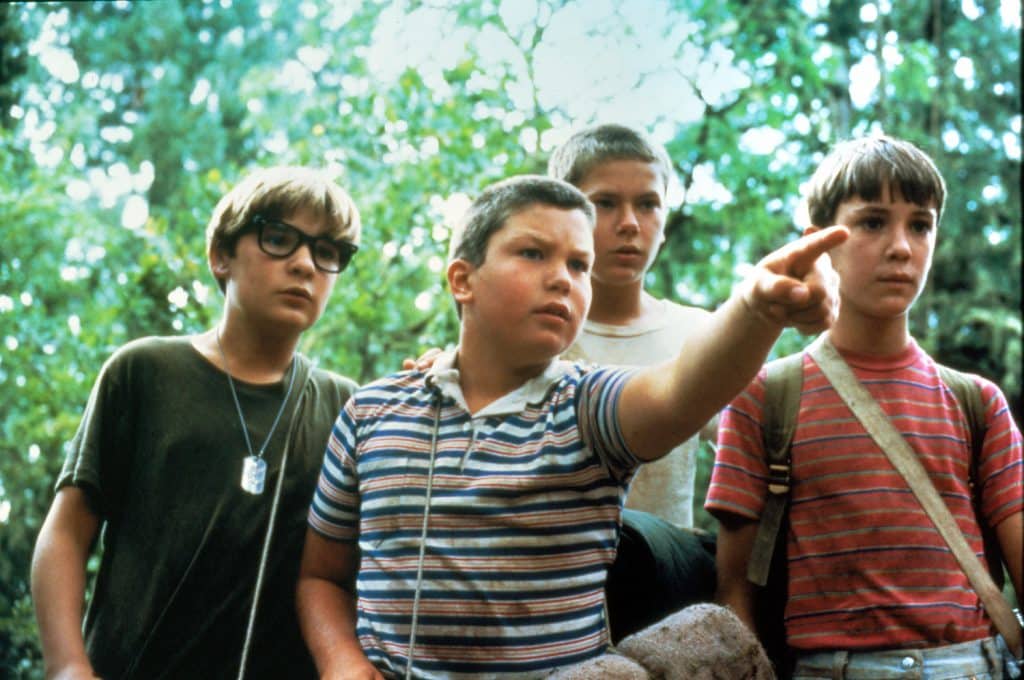Stephen King’s bittersweet tale of tween boy friendship is scare-free but full of heart.
Every month, we at The Spool select a filmmaker to explore in greater depth — their themes, their deeper concerns, how their works chart the history of cinema and the filmmaker’s own biography. This month, we ring in the release of It: Chapter Two by exploring the various adaptations of the master of horror, Stephen King. Read the rest of our coverage here.
When pitching Stranger Things to various TV outlets, one constant problem The Duffer Brothers encountered was that TV executives didn’t want the show to star children unless it was geared exclusively towards a young audience. Given how successful the show was, as well as the first It movie and its own child leads, it’s hard to imagine anyone nowadays turning down a thriller TV show just because it starred kids. Heck, even before those modern-day properties came about, it’s puzzling that TV executives were so resistant to the idea given that the 1980s was rife with successful adult-skewing properties starring children.
One such property was Stand by Me, which, alongside fellow 1980s classic The Goonies, established the broad strokes of a narrative involving a group of kids going on an adventure that the likes of Stranger Things and the first It film are paying homage to in current pop culture. Stand by Me is a more grounded and introspective tale than much of the art it’s inspired. This tale focuses on a quartet of kids, Gordie (Wil Wheaton), Chris (River Phoenix), Teddy (Corey Feldman) and Vern (Jerry O’Connell) making a two-day trek in the summer of 1959 to take a peek at a dead body located deep in the woods. The journey is riddled with adventures including a close encounter with a train, outracing a fearsome dog and coming to terms with their own personal problems. All of it is narrated by a grown-up version of Gordie, played by Richard Dreyfuss.
The narration by Dreyfuss cements the melancholy nature of the proceedings, which is perhaps the most notable way Stand by Me differentiates itself from other pop culture properties it helped to spawn. Whereas something like Stranger Things is so enamored with 1980s nostalgia that it’ll stop its plot dead in its tracks just to have a character sing the praises of New Coke by comparing it to John Carpenter’s The Thing, Stand by Me is more interested in using its story to communicate a wistful tone than poking nostalgia buttons. Sometimes this tone comes from Dreyfuss’ narration, which has an adult version of Gordie looking back on his own childhood follies with equal levels of amusement and sorrow.

Most of the time though, the more mournful nature of Stand by Me comes from the kid characters grappling with their own personal issues. Gordie is still reeling from the sudden death of his brother (played by a young John Cusack), Teddy yearns to be like his father, who’s stuck in an insane asylum, and Chris is convinced that he can never amount to anything in life simply because of the lowly position his family occupies in the eyes of the local townspeople. This is heady stuff to deal with when you’re an adult, let alone when you aren’t even old enough to be in junior high school yet. Such personal turmoil provides some of the most emotionally moving moments of the screenplay penned by Bruce A. Evans and Raynold Gideon, especially since the writers smartly refuse to give tidy closure to the individual struggles of the lead characters.
This dedication to not offering up easy answers for the child lead characters is exemplified in closing narration from Gordie explaining what happened to his three friends as they got older. Such narration only punctuates the melancholy nature of their individual plights as he notes how Teddy ended up in prison and Chris was killed trying to break up a fight. There isn’t much in the way of catharsis for either the viewer or the characters here, but at least the adolescent protagonists do find some solace in their interactions with one another. Young Chris and Gordie sharing heart-to-heart talks with each other won’t automatically solve all their problems but it does allow them to realize they’re not the only ones processing emotional trauma. Plus, such scenes are mighty touching to watch under the solid direction of Rob Reiner.
Young Chris and Gordie sharing heart-to-heart talks with each other won’t automatically solve all their problems but it does allow them to realize they’re not the only ones processing emotional trauma.
It’s very much worth mentioning that Stand by Me is adapted from the Stephen King novella The Body. Though not a horror tale like many of his books, Stand by Me still features a number of King staples, most notably in setting the tale in Castle Rock, Oregon in the 1950s. The successful nature of this adaptation, as well as Reiner’s Reiner second King adaptation Misery, leads one to ponder if the best Stephen King novels to adapt into feature-length movies are smaller-scale ones. Many of King’s texts, like Under the Dome or The Dark Tower, are such expansive works that they could never be translated into a feature film properly, trying to do so is like trying to a fit a square peg into a circular hole. A more restrained narrative about four boys going on a two-day journey to a dead body, however, that’s much more manageable as cinematic storytelling.
Meanwhile, other noteworthy Stephen King adaptations like Misery and The Mist aren’t just similarly smaller-in-scale in their storytelling, they both take place primarily in one location! King’s works have an overall mixed track record in getting adapted to film but when they’re more compact in terms of setting and scope, that’s when you tend to get better movies like Stand by Me. Of course, this entertaining movie has many noteworthy qualities beyond just how it exemplifies the best type of Stephen King literature to adapt. Perhaps most notably, it shows folks like the TV executives that initially rejected Stranger Things that thoughtful storytelling confronting heady emotional issues can be done with child protagonists. After all, if there’s anything someone like Gordie Lachance knows better than anyone, it’s that you can still be impacted by the horrors of the world even when you’re only twelve.

